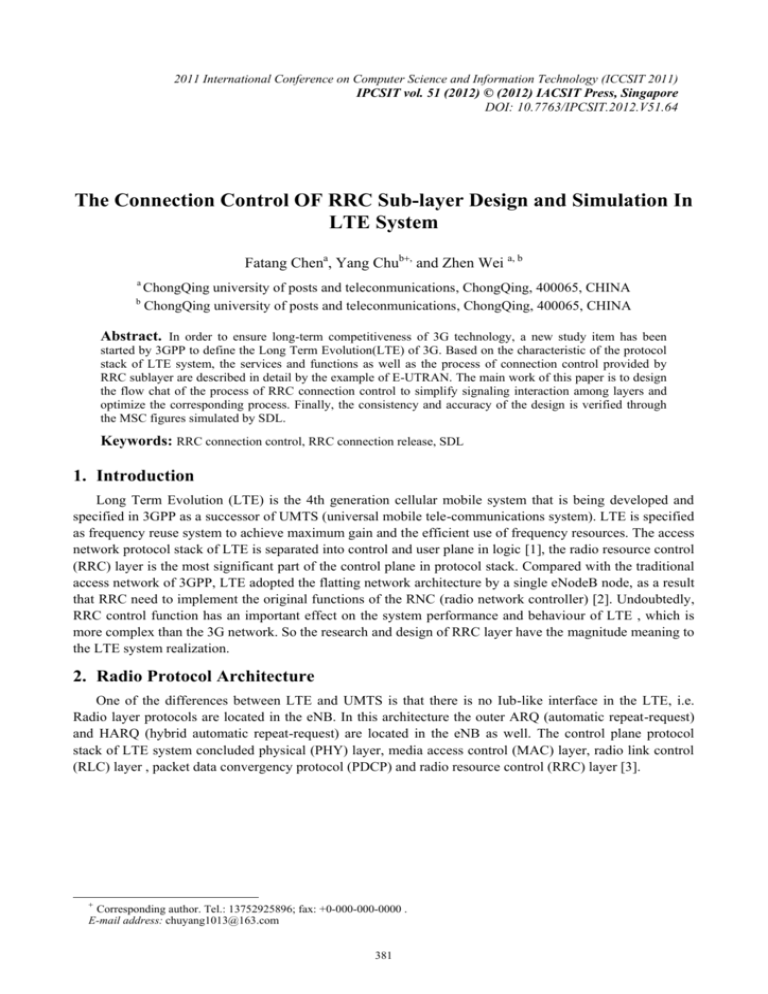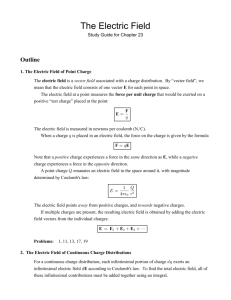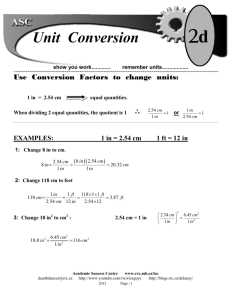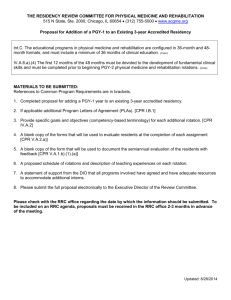The Connection Control OF RRC Sub
advertisement

2011 International Conference on Computer Science and Information Technology (ICCSIT 2011) IPCSIT vol. 51 (2012) © (2012) IACSIT Press, Singapore DOI: 10.7763/IPCSIT.2012.V51.64 The Connection Control OF RRC Sub-layer Design and Simulation In LTE System Fatang Chena, Yang Chub, and Zhen Wei a, b a b ChongQing university of posts and teleconmunications, ChongQing, 400065, CHINA ChongQing university of posts and teleconmunications, ChongQing, 400065, CHINA Abstract. In order to ensure long-term competitiveness of 3G technology, a new study item has been started by 3GPP to define the Long Term Evolution(LTE) of 3G. Based on the characteristic of the protocol stack of LTE system, the services and functions as well as the process of connection control provided by RRC sublayer are described in detail by the example of E-UTRAN. The main work of this paper is to design the flow chat of the process of RRC connection control to simplify signaling interaction among layers and optimize the corresponding process. Finally, the consistency and accuracy of the design is verified through the MSC figures simulated by SDL. Keywords: RRC connection control, RRC connection release, SDL 1. Introduction Long Term Evolution (LTE) is the 4th generation cellular mobile system that is being developed and specified in 3GPP as a successor of UMTS (universal mobile tele-communications system). LTE is specified as frequency reuse system to achieve maximum gain and the efficient use of frequency resources. The access network protocol stack of LTE is separated into control and user plane in logic [1], the radio resource control (RRC) layer is the most significant part of the control plane in protocol stack. Compared with the traditional access network of 3GPP, LTE adopted the flatting network architecture by a single eNodeB node, as a result that RRC need to implement the original functions of the RNC (radio network controller) [2]. Undoubtedly, RRC control function has an important effect on the system performance and behaviour of LTE , which is more complex than the 3G network. So the research and design of RRC layer have the magnitude meaning to the LTE system realization. 2. Radio Protocol Architecture One of the differences between LTE and UMTS is that there is no Iub-like interface in the LTE, i.e. Radio layer protocols are located in the eNB. In this architecture the outer ARQ (automatic repeat-request) and HARQ (hybrid automatic repeat-request) are located in the eNB as well. The control plane protocol stack of LTE system concluded physical (PHY) layer, media access control (MAC) layer, radio link control (RLC) layer , packet data convergency protocol (PDCP) and radio resource control (RRC) layer [3]. Corresponding author. Tel.: 13752925896; fax: +0-000-000-0000 . E-mail address: chuyang1013@163.com 381 2nd connection of UE 1st connection of UE PDCP SDU1 PDCP SDU2 P D C P PDCP SDU3 PDCP SDU4 PDCP SUD1 RoHC Robust Header Compression (RoHC) P Pavload P Pavload P Pavload P Pavload P Pavload Segmentation/ Concatenation Segmentation/Concatenation R L C ARQ R S Pavload R S Pavload S ARQ Pavload S Pavload R S Pavload R S Pavload Scheduling&Multiplexing M A C Pavload P H Y TB Pad Pavload Pad Pavload Pad HARQ CRC TB CRC TB CRC P-PDCP header; R-RLC-PDU header; S-RLCsegment header; Pad-Pading (if needed); TB-Transport block Fig.1 User-plane data flow through link layer The PDCP is responsible for header compression and decompression using Robust Header Compression (RoHC). The RLC provides AM or UM (acknowledged or unacknowledged mode) data transfer service, performs segmentation and concatenation if necessary, error correction by retransmissions in AM through ARQ and ensures in-sequence delivery of SDUs. Scheduling, HARQ processing and assembling transport blocks (TB) for the physical layer are done at the MAC. Fig.1 illustrates the basic data flow through the link layer in downlink. In order to decrease the overhead caused by the link layer, the segmentation in RLC is done only after the available TB size is indicated by the physical layer, which will result in variable-sized RLC PDUs (packet data unit). The ARQ retransmits either RLC SDUs (IP packets) or RLC segments. ARQ retransmission decisions can be based on ARQ-HARQ interactions i.e. Based on the information received from HARQ about the status of a TB (HARQ-assisted ARQ). The packet scheduler is located in the MAC and operates with a scheduling period of 0.5 ms, hence the available radio resources (e.g. Time/frequency chunks or resource blocks) are redistributed between the users by taking into account the negotiated QoS requirements, amount of buffered data for each connection, instantaneous radio channel conditions, actual DTX/DRX (discontinuous transmission/reception) circumstances and UE capabilities during this period. In downlink, all information is available in the eNBs, but the data buffers are located in the UEs, buffer status reports are required from the UEs in order to implement QoS-ware scheduling. The HARQ functionality user N-process Stop-and-Wait algorithm and supports incremental redundancy and chase combining. As the control entity of the whole LTE, RRC accomplishes the functions such as broadcasting, paging, information security, radio bearer management, handover and measurement management through the interfaces of RRC_EMM, RRC_PDCP, RRC_RLC, RRC_MAC and RRC_PHY, and controls the behaviours of the lower protocols in order to make E-UTRAN utmost possible to satisfy the need of users for the radio resource management through some mechanisms. Layer 3 protocols are mainly formed of radio resource control (RRC) layer, which mainly provides the following services [4]: Coding through ASN.1 (abstract syntax notation.1) and broadcasting System Information (SI), also configuring the MAC to achieve the scheduling of broadcasting SI; In this process the ASN.1 decoding design is a more important and complicated; Paging. The purpose of it is to transmit paging message for the special UE through the Paging Control Channel (PCH), this process is initiated by upper layer to establish signaling connection; Random access control. If checking the following conditions, UE will initiate the random access process: mobile originating/ terminating calls in RRC_IDLE, handover and downlink/ uplink data arrives while needing random access process, which is divided into contention resolution ones and non-contention resolution; Connection control. It mainly includes the RRC connection establishment/ holding and release, the configuration of the lower layers, the assignment of temporary identifier, and also the establishment or 382 release of SRB1/ SRB2/ DRBs, ect; Measurement control; Security control. Including the generation of access layer security key, etc; Mobility control. Including the handover management, the cell selection and reselection, the communication context transmission between eNodeBs, etc. In addition, RRC also provides management for QoS (Quality of Service), MBMS (Multimedia Broadcast Multicast Service) and so on. 3. The State Transition and Connection Control Process of RRC in E-UTRAN RRC layer is separated into two states in LTE system as usual: RRC_IDLE and RRC_CONNECTED [5], during the RRC_IDLE there are three sub-states, such as the null state (NUL), cell selection (SEL) and the idle state (IDL); then the RRC_CONNECTED is also separated into three sub-states which are random access state (ACC), the normal connection state (CON) and the handover (HO). A UE is in RRC_CONNECTED when an RRC connection has been established. If not, the UE is in RRC_IDLE. During the RRC_IDLE, the UE is identified by the identifier of the NAS. While needing to search for a special UE, E_UTRAN initiates the paging procedure by transmitting the Paging message at the paging occasion of UE. The radio network temporary identifier (C-RNTI) will be assigned to UE as the identifier of common control channel during RRC_ CONNECTED. The flow of RRC in E-UTRAN mainly involves that: being in the RRC_IDLE after power on, sending paging message and the notice of system information change during the RRC_IDLE, RRC connection establishment, the activation of NAS and AS (access stratum) security mode, RRC connection reconfiguration, RRC connection release, etc. Paging is used to send paging message to UE which is in the tracking area during RRC_IDLE and trigger UE to establish SRB1. Security activation is defined that E_UTRAN active and configure UE with integrity protection and ciphering algorithm after the establishment of SRB1 between the E_UTRAN and UE. The purpose of RRC connection establishment is to establish an RRC connection and SRB1 between UE and eNodeB. RRC connection re-establish involves the resumption of SRB1 operation and re-activation of security upon detecting radio link failure or handover failure. RRC connection reconfiguration is aim to modify an RRC connection, it also can be used as the trigger process of handover. UE release the established radio bearers as well as all radio resources and return to RRC_IDLE while RRC connection release. The following mainly introduce the process of paging and system information change in IDLE, RRC connection establish and release. 3.1. The State of Power On The upper layer sends a instruction of power on to configure system message, MMEC and other related parameters. By using the primitive--CMAC_IDL _CONFIG _REQ and CPHY_IDL_CONFIG_REQ, the MAC and PHY can be configured into the IDLE state. UE will always camp on the suitable cell before receiving paging or a call initiated by upper layer. In this case, there isn't any uplink physical channel connection between UE and E-UTRAN, and UE can monitor the broadcast channel, maintenance and updata the system information of the serving cell; Make the measurements of attributes of the serving and neighbour cells to enable the reselection process, if found one satisfy the cell reselection criteria. The flow of power on in IDLE is shown in Fig.2: Fig.2 The flow chat in IDLE 383 3.2. Sending Paging Message and the Notice of System Information Change During RRC_IDLE When the upper indicates system information have changed, RRC requests MAC to send paging message through the primitive CMAC_PCH_INFO_REQ, then configures MAC into IDLE state through the primitive CMAC_IDL_CONFIG_REQ in order to send system information and paging messages, after that, confirms the result of system information change to EMM through the primitive EMMAS_SYSINFO_CHANGE_CNF, EMM layer informs RRC the arriving of paging message through EMMAS_PAGE_REQ and requests RRC assembled paging messages, sends the primitive CMAC_IDL_CONFIG_REQ. The process of sending paging message and the notice of system information change during the IDLE state is shown in Fig.3. The purpose of paging is to transmit paging messages to a UE in RRC_IDLE or inform UEs in RRC_IDLE and UEs in RRC_CONNECTED about a system information change and also can inform about an ETWS (Earthquake And Tsunami Warning System) notification and/ or a CMAS (Commercial Mobile Alert Service) notification. E-UTRAN initiates the paging procedure by transmitting the Paging message at the paging occasion of UE. E-UTRAN may address multiple UEs within a Paging message by including one PagingRecord for each UE. Paging message can be used to inform one or more UEs, using RLC TM mode, mapped to PCCH logical channel. UE monitor the paging channel to check whether there is calling in RRC_IDLE, upon receiving the Paging message. For each of the PagingRecord, if the ue-Identity included in the PagingRecord matches one of the UE identities allocated by upper layers, then forwards the ue-Identity and cn-Donmain to upper layers. Because UE can reduce power consumption in RRC_IDLE by DRX, It must be able to calculate when to wake up DRX and check the correct subframe. In order to accomplish that, UE need to store the default paging periods and paging groups when receiveing necessary information from SIB2. S-TMSI (SAE Temporary Mobile Station Identifier) or IMSI (international mobile subscriber identity) can identify UE, and S-TMSI is temporary UE_ID distributed by MME (mobility management entity). Whenever the value of DRX parameter has changed in SI, it will be updataed in UE. If there is no IMSI, UE will adopt the default identifier UE_ID=0. System information not only includes the information related with the non access stratum but also the access stratum. Based on the nature of information, it can be divided into MIB and different SIBs [6]. The MIB uses a fixed schedule with a periodicity of 40 ms and repetitions made within 40 ms. The first transmission of the MIB is scheduled in subframe #0 of radio frames for which the SFN mod 4=0 ,and repetitions are scheduled in subframe #0 of all other radio frames. UE obtain the MIB, which contains a downlink system bandwidth and a system frame number (SFN) which is configured by the physical HARQ (hybrid automatic repeat-request) instruction channel (PHICH), to decode the SCH (synchronization channel). The SIB1 uses a fixed schedule with a periodicity of 80 ms and repetitions made within 80 ms. The first transmission of SIB1 is scheduled in subframe #5 of radio frames for which the SFN mod 8 = 0, and repetitions are scheduled in subframe #5 of all other radio frames for which SFN mod 2 = 0. SIB1 defines the scheduling of other system information blocks and contains relevant information, such as band instructions, TDD configuration, the length of SI-Window and System Information Value Tag. Besides the SIB1, the other SIBs are all contained in SI messages, which are transmitted within periodically occurring time domain windows using dynamic scheduling. Each SI message is associated with a SI-window and the SI-windows of different SI messages do not overlap. Fig3.The flow chat of the paging and system information change in IDLE 384 3.3. RRC Connection Establishment of E-UTRAN Connection establishment is triggered by the request of NAS from the UE. There are many kinds of trigger reasons, such as mobile originating calls, NAS signalling transmission or paging response transmission and so on [8]. The RRC connection establishment involves SRB1 establishment between UE and E-UTRAN. After the MAC of E-UTRAN indicates the reception of the UE's random access request, it will go into the random access state, then RRC begins to configure the MAC and RLC with default value. UE sends "RRCConnectionRequest" message to E-UTRAN and waits for receiving "RRCConnectionSetup" message or others from E-UTRAN; If the network is over loading, the eNodeB can configure the visiting forbidden parameter of SIB2 reasonably or use the counter to refuse the RRC connection request. If the UE has a legal S-TMSI, which will be contained in RRC connection request. Otherwise, UE also has 40 bit random value. Because of the restriction of message's length, it only defines five connection establishment reasons, such as emergency state\ higher-priority visiting\ mobile terminating calls\ mobile originating signalling and mobile originating data. The MAC of E-UTRAN send RRCConnection Request message to RRC through the primitive CMAC_ CCCH_INFO_REQ, then RRC initiates the primitive CMAC_CCCH_INFO_REQ\ CPDCP_ CONFIG _REQ\ CRLC _CONFIG _REQ as well as CMAC_ CONNECT_CONFIG_REQ to configure MAC\ PDCP\ RLC and transfers "RRCConnectionSetup" message to UE. Based on the radio resource configuration dedicated information in the "RRCConnectionSetup" message, UE will configure the MAC and RLC, which adopts AM mode to send "RRCConnectionSetupComplete" message through the DCCH, at the same time, the physical layer will make transmission and reception synchronous [7]. SIB1 can broadcast six PLMN (public lands mobile network) identifiers at best, one of which can be chosen by UE and reported in "RRCConnectionSetupComplete" message. After receiving the RRCConnectionSetupComplete message of UE, E-UTRAN will go into the connection state. The flow of RRC in E-UTRAN connection establishes successfully is shown in Fig.4: Fig4. The flow chat of the RRC connection setup successful in E-UTRAN 3.4. RRC Connection Release of E-UTRAN E-UTRAN initiates the RRC connection release procedure to a UE in RRC_CONNECTED, the purpose of it is to release the RRC connection, which includes the release of the established radio bearers as well as all radio resources. EMM requests RRC to release the S1 connection through the primitive EMMAS_S1_RELEASE_COMMAND and triggers the primitive CPDCP_RELEASE_REQ\ CRLC_ DEACT_REQ as well as CMAC _IDL _CONFIG _REQ to release the PDCP and RLC entity and configure MAC into IDLE to transfer the system information as well as the paging messages. The flow of RRC connection release in E-UTRAN is shown in Fig.5: Fig5.The flow chat of the RRC connection release in E-UTRAN 385 3.5. The SDL Simulation of RrcConnection Control In E-utran SDL is a language which is used to describe the system behaviours, it is developed and standardized by ITU-T from 1976 to 1992, it's mathematical model is the extended finite state machine (EFSM) [9]. Telecommunications system and protocol are the main applications of SDL, which has two expressions of graphics and text, such as SDL/GR and SDL/PR [10]. It not only can explain the system function, but also the internal structure and behaviour. SDL divides the application into two sides: SDL system and environmental. SDL system is paid more attention by the designers, which is explained and described in SDL language, the part except the system is called environment. It can be communicated through signal between system and environment. This paper uses TelelogicTau4.0 test software to simulate the design of the flow of the system information change\ paging\ connection establishment and release among PHY\ MAC\ RLC\ PDCP\ RRC and EMM layers in E-UTRAN. The simulation diagram is shown below: Fig6.The MSC of sending systeminformation changed and paging message in E-UTRAN 386 Fig7.The MSC of the RRC connection setup and release in E-UTRAN 4. Conclusion In LTE system protocol stack, each layer plays a different role, and executes different tasks in each process. Among them, RRC located in the layer 3 of access stratum, it's the control center of access stratum which belongs to the control plane. This article mainly introduces the protocol framework of RRC as well as services and functions provided in LTE system, set the E-UTRAN as an example, describes the process of RRC connection control in detail, especially the producer of system information change\ paging messages transmission and connection establishment\ release. Beyond that, the article still designs the relevant flow, and at last verifies the consistency and accuracy of the design through the MSC figures simulated by SDL. 5. Acknowledgements This work is supported by Major Project of National Science and Technology in Development of TDLTE Wireless Integrated Test Instrument, and under Grant no.2009ZX03002-009. 6. References [1] 3GPP TS 36.213 V9.2.0. Evolved Universal Terrestrial Radio Access (E-UTRA); Physical layer procedures[S], 2010. [2] 3GPP TS 36.401 V9.2.0.Evolved Universal Terrestrial Radio Access Network (E-UTRAN); Architecture description[S], 2010. [3] 3GPP TS 36.300 V9.2.0. Evolved Universal Terrestrial Radio Access (E-UTRA) and Evolved Universal Terrestrial Radio Access Network (E-UTRAN); Overall description; Stage 2[S], 2010. 387 [4] 3GPP.TS36.331 V9.2.0 Evolved Universal Terrestrial Radio Access (E-UTRA)Radio Resource Control (RRC)[S/OL], 2010. [5] Pekka H.J. Petala, Antonio Barbuzzi, Gennaro Boggia, and Kostas Pentikousis. Theory and Practice of RRC State Transitions in UMTS Networks[J]. IEEE Broadband Wireless Access Workshop, 2009. [6] XiaoWen Li, GuiYong Li, XianLiang Chen. TD-SCDMA third generation mobile telecommunication system\ signalling and realization [M], BeiJing: POSTS&TELECOM PRESS, 2003. [7] A.Larmo, M. Lindstrom, M. Meyer, G. Pelletier, J. Torsner, H. Wieman,"The LTE Link Layer Design", IEEE Commun. Magazine, vol. 47, no 4. Apr. 2009. [8] KePing ZHang. LTE-B3G/4G Wireless Mobile Communication System [M]. BeiJing: PUBLISHING HOUSE OF ELECTRONICS INDUSTRY, 2008. [9] R.J., Skehill, I. Rics, and S. McGrath, SDL System Development of Distributed UMTS Signalling Layers. In 2nd Annual ICT Information Technology and Telecommunications, 2002. [10] MaoQiang Song. Based Telecommunication software design [M], BeiJing: BEIJING UNIVERSITY OF POSTS AND TELECOMMUNICATIONS PRESS, 2008. 388







